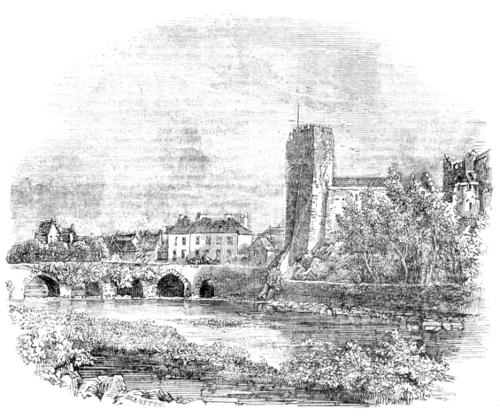THE IRISH PENNY JOURNAL.
| Number 33. | SATURDAY, FEBRUARY 13, 1841. | Volume I. |

CAHIR CASTLE, COUNTY OF TIPPERARY
To a large portion of our readers it will be scarcely necessaryto state, that the little town of Cahir is in many respectsthe most interesting of its size to be found in theprovince of Munster, we had almost said in all Ireland; andthat, though this interest is to a considerable extent derivedfrom the extreme beauty of its situation and surroundingscenery, it is in an equal degree attributable to a rarer qualityin our small towns—the beauty of its public edifices, andthe appearance of neatness, cleanliness, and comfort, whichpervades it generally, and indicates the fostering protectionof the noble family to whom it belongs, and to whom it ancientlygave title. Most of our small towns require brilliantsunshine to give them even a semi-cheerful aspect: Cahirlooks pleasant even on one of our characteristic gloomy days.As it is not, however, our present purpose to enter on anydetailed account of the town itself, but to confine our noticeto one of its most attractive features—its ancient castle—weshall only state that Cahir is a market and post town, in thebarony of Iffa and Offa West, county of Tipperary, and issituated on the river Suir, at the junction of the mail-coachroads leading respectively from Waterford to Limerick, andfrom Cork by way of Cashel to Dublin. It is about eightmiles W.N.W. from Clonmel, and the same distance S.W.from Cashel, and contains about 3500 inhabitants.
The ancient and proper name of this town is Cahir-duna-iascaigh,or, the circular stone fortress of the fish-aboundingDun, or fort; a name which appears to be tautological, andwhich can only be accounted for by the supposition that anearthen Dun, or fort, had originally occupied the site onwhich a Cahir, or stone fort, was erected subsequently.Examples of names formed in this way, of words havingnearly synonymous meanings, are very numerous in Ireland,as Caislean-dun-more, the castle of the great fort, and asthe Irish name of Cahir Castle itself, which, after the erectionof the present building, was called Caislean-na-caherach-duna-iascaigh,an appellation in which three distinct Irishnames for military works of different classes and ages arecombined.
Be this, however, as it may, it is certain that a Cahir orstone fort occupied the site of the present castle in the mostremote historic times, as it is mentioned in the oldest books ofthe Brehon laws; and the Book of Lecan records its destruction[Pg 258]by Cuirreach, the brother-in-law of Felemy Rechtmar,or the Lawgiver, as early as the third century, at whichtime it is stated to have been the residence of a female namedBadamar. Whether this Cahir was subsequently rebuilt ornot, does not appear in our histories as far as we have found;nor have we been able to discover in any ancient document arecord of the erection of the present castle. It is stated indeedby Archdall, and from him again by all subsequent Irishtopographers, that Cahir Castle was erected prior to the year1142 by Conor-na-Catharach O’Brien, king of Thomond.But this is altogether an error. No castle properly so calledof this class was erected in Ireland till a later period, and theassertion of Conor’s having built a ca